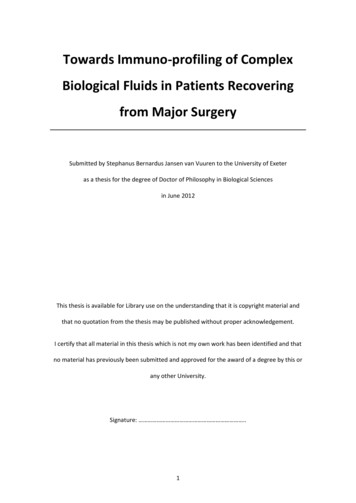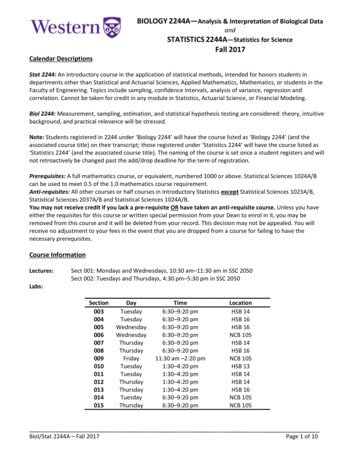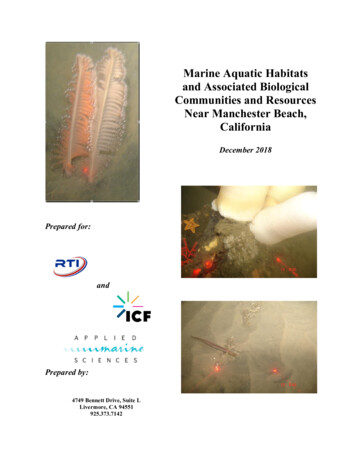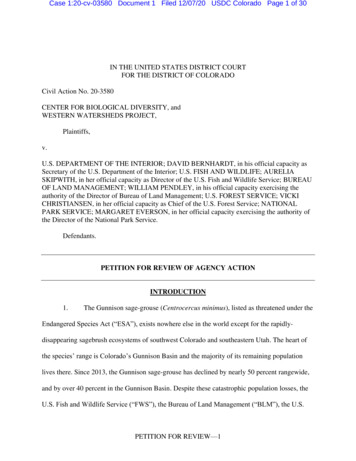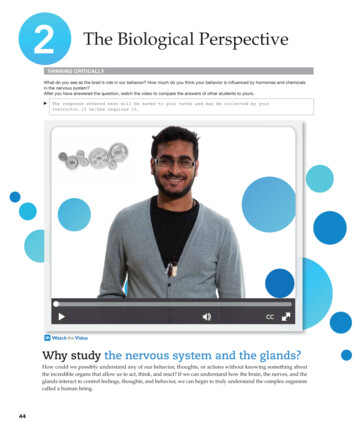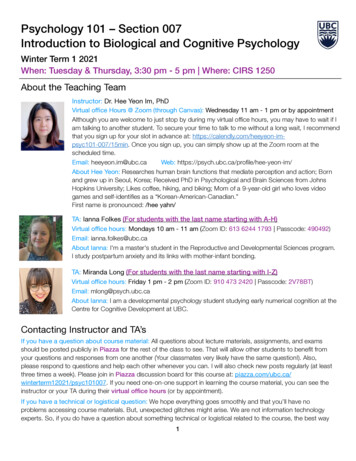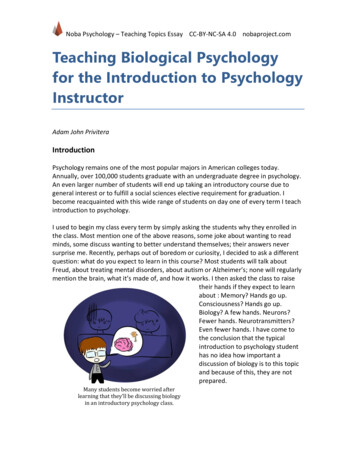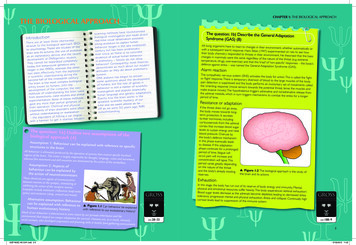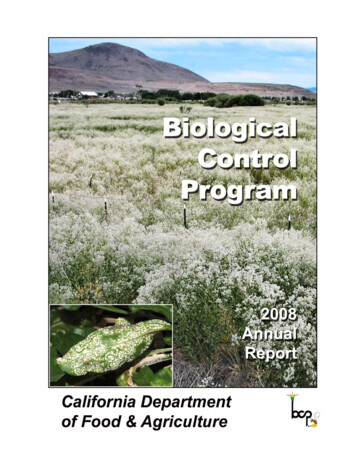
Transcription
BIOLOGICAL CONTROL PROGRAM2008 SUMMARYDeveloped by:Jim BrownKris GodfreySyed KhasimuddinCharles PickettMike PitcairnWilliam RoltschBaldo VillegasDale WoodsLue YangCALIFORNIA DEPARTMENT OF FOOD AND AGRICULTUREPLANT HEALTH AND PEST PREVENTION SERVICESINTEGRATED PEST CONTROL BRANCHCite as: Dale M. Woods, Editor, 2009, Biological Control Program 2008 Annual Summary,California Department of Food and Agriculture, Plant Health and Pest Prevention Services,Sacramento, California. 69pp.
CDFA CONTRIBUTING PERSONNELMr. Jim BrownDr. Kris GodfreyDr. Syed KhasimuddinDr. Charles PickettDr. Mike PitcairnDr. William RoltschMr. Baldo VillegasDr. Dale WoodsMr. Lue YangCDFA Technical AssistantsMs. Penny BaxleyMs. Kathleen CassanaveMs. Lia ChaseMs. Leann HorningMs. Chia MouaMs. Viola PopescuMs. Nancy SaechaoMr. Ciprian SimonCounty Co-operator AcknowledgementThe CDFA Biological Control Program greatly appreciates the many biologists and agriculturecommissioners throughout the state whose co-operation and collaboration made this work possible.FOR OFFICIAL USE ONLYThis report contains unpublished information concerning work in progress. The contents of thisreport may not be published or reproduced in any form without the prior consent of the researchworkers involved.Cover developed by Baldo Villegas, Dale Woods, and John P. Mattia (Orange, CT). Infestation of perennialpepperweed east of Susanville, California. (Photo courtesy of Lassen County Weed Management Area). Insetphoto shows severe infection of perennial pepperweed by the plant pathogen, Albugo candida. (Photo byVillegas and Woods)
COOPERATING SCIENTISTSMs. Jodi Aceves, Siskiyou County Department of Agriculture, Yreka, CaliforniaDr. Pat Akers, CDFA, Integrated Pest Control Branch, Sacramento, CaliforniaDr. Lars Anderson, USDA-ARS, Davis, CaliforniaMr. John Andrews, University of California, Berkeley, CaliforniaDr. Joe Balciunas, USDA-ARS, Albany, CaliforniaDr. Loretta Bates, University of California, Cooperative Extension, San Marcos, CaliforniaMr. James Bethke, University of California, Cooperative Extension, San Marcos, CaliforniaMr. Arnaud Blanchet, USDA-ARS European Biological Control Laboratory, Montferrier, FranceMr. Gary W. Brown, USDA-APHIS-PPQ, Portland, OregonDr. William L. Bruckart, USDA-ARS, Ft. Detrick, MarylandMs. Janet Bryer, University of California, Santa Cruz, CaliforniaMs. Linda Buergi, University of California, Berkeley, CaliforniaDr. Anne-Marie Callcott, USDA, APHIS, Gulfport, MississippiDr. Nada Carruthers, USDA-APHIS-CPHST, Albany, CaliforniaDr. Ray Carruthers, USDA-ARS, Albany, CaliforniaDr. Al Cofrancesco, United States Army Corps of Engineers, MississippiMr. Eric Coombs, Oregon Department of Agriculture, Salem, OregonMs. Monica Cooper, University of California, Berkeley, CaliforniaMr. Dominique Coutinot, USDA-ARS European Biological Control Laboratory, Montferrier, FranceMr. Massimo Cristofaro, Biotechnology and Biological Control Agency, Rome, ItalyDr. Kent Daane, University of California Berkeley, Berkeley, CaliforniaDr. B. Vasantharaj David, Sun Agro Biotech Research Ctr., Madanandapuram, Porur, Chennai, IndiaDr. Joe M. DiTomaso, University of California, Davis, CaliforniaDr. Tracy Ellis, San Diego County Department of Agriculture, San Diego, CaliforniaDr. Martin Erlandson, Agri-Food and Agriculture Canada, Saskatoon, Saskatchewan, CanadaDr. Alison Fisher, USDA-ARS, Albany, CaliforniaDr. John Gaskin, USDA-ARS, SREC, Sydney, MontanaMs. Carolyn Gibbs, US Department of Interior, BLM, Susanville, CaliforniaMr. Raymond Gill, CDFA, Plant Pest Diagnostics Laboratory, Sacramento, CaliforniaDr. André Gassmann, CABI Bioscience, Delémont, SwitzerlandDr. John A. Goolsby, USDA-ARS, Brownsville, TexasDr. Tom Gordon, University of California, Davis, CaliforniaDr. Henri Goulet, Agriculture and Agri-Food Canada, Ottawa, Ontario, CanadaDr. Elizabeth Grafton-Cardwell, University of California, Kearney Ag Center, Parlier, CaliforniaMr. Daniel Hamon, USDA-APHIS-PPQ, Western Region, Sacramento, CaliforniaDr. Rich Hansen, USDA-APHIS, Fort Collins, ColoradoDr. Yurong He, Southern China Agricultural University, Tianhe District, Guangzhou, ChinaDr. David Headrick, California Polytechnic State University, San Luis Obispo, CaliforniaDr. John Herr, USDA-ARS, Albany, CaliforniaDr. Hariet Hinz, CABI Bioscience, Delemont, SwitzerlandDr. Mark Hoddle, University of California, Riverside, CaliforniaDr. Kim Hoelmer, USDA-ARS, Beneficial Insect Introduction Research Unit, Newark, DelawareDr. Fred Hrusa, CDFA, Plant Pest Diagnostics Center, Sacramento, CaliforniaDr. Eduardo Humeres, University of California, Riverside, CaliforniaDr. John Irish, National Botanical Research Institute, Windhoek, NamibiaDr. Marshall Johnson, University of California, Kearney Ag Center, Parlier, CaliforniaMs. Jolena Jordan, CDFA, Pierce’s Disease Control Program, Riverside, CaliforniaDr. Walker Jones, USDA-ARS, European Biological Control Laboratory, Montferrier, France
Mr. Javid Kashefi, USDA-ARS European Biological Control Laboratory, Thessaloniki, GreeceMs. Sharon Kirkpatrick, University of California, Davis, CaliforniaMr. Dan Keaveny, CDFA, Integrated Pest Control Branch, Shafter, CaliforniaDr. David Kellum, San Diego County Department of Agriculture, San Diego, CaliforniaDr. Alan Kirk, USDA-ARS, European Biological Control Laboratory, Montferrier, FranceMr. David Kratville, CDFA, Integrated Pest Control Branch, Sacramento, CaliforniaMr. Marc Lea, San Luis Obispo Department of Agriculture, San Luis Obispo, CaliforniaMs. Peris Machera, International Center for Insect Physiology and Ecology, Nairobi, KenyaMr. Stan Maggi, Santa Clara Department of Agriculture, San Jose, CaliforniaDr. Zvi Mendel, Agriculture Research Organization, Volcani Center, Bet-Dagan, IsraelDr. Russel Messing, University of Hawaii, Kapaa, HawaiiDr. Nick Mills, University of California, Berkeley, CaliforniaDr. David J. W. Morgan, CDFA, Pierce’s Disease Control Program, Riverside, CaliforniaDr. Joseph Morse, University of California, Riverside, CaliforniaMr. Diego Nieto, University of California, Santa Cruz, CaliforniaDr. Jorge Peña, University of Florida, Homestead, FloridaMr. Pete Peterson, California Polytechnic State University, San Luis Obispo, CaliforniaMs. Carri Pirosko, CDFA, Integrated Pest Control Branch, Burney, CaliforniaDr. Marcel Rejmanek, University of California, Davis, CaliforniaDr. Kristina Schierenbeck, USDA-ARS, Reno, NevadaDr. P. Selvaraj, Sun Agro Biotech Research Ctr., Madanandapuram, Porur, Chennai, IndiaDr. Rene Sforza, USDA-ARS, European Biological Control Laboratory, Montferrier, FranceDr. Andy Sheppard, CSIRO, Camberra, AustraliaDr. Karen Sime, University of California, Berkeley, CaliforniaDr. Lincoln Smith, USDA-ARS, Albany, CaliforniaDr. Norm Smith, Fresno County Department of Agriculture, Fresno, CaliforniaDr. David Spencer, USDA-ARS, Davis, CaliforniaDr. Richard Stouthammer, University of California, Riverside, CaliforniaDr. Sean L. Swezey, University of California, Santa Cruz, CaliforniaDr. Sergei Triapitsyn, University of California, Riverside, CaliforniaDr. Xin-geng Wang, University of California, Kearney Ag Center, Parlier, CaliforniaDr. Gillian Watson, CDFA, Plant Pest Diagnostics Laboratory, Sacramento, CaliforniaDr. Robert Wharton, Texas A & M University, College Station, TexasDr. Livy Williams, USDA-ARS, Reno, NevadaMr. Rob Wilson, University of California Cooperative Extension, Susanville, CaliforniaDr. Frank Zalom, University of California, Davis, California
PrefaceM. J. PitcairnI am always encouraged to hear from individuals who let us know their appreciation forour efforts and the impacts of one of our projects. As a state program, our traditional immediatecustomers are the County Agricultural Commissioners who assist us in the release andestablishment of new biological control organisms statewide. We also interact with several stateand federal agencies that manage public lands and need help controlling invasive noxious pests.But, occasionally, we get notes from individuals that belong to small local organizations.Recently, we received thank you notes concerning the possible release of a new biologicalcontrol agent on Russian thistle. This common but noxious weed affects California in manydifferent ways: large tumbling plants cross highways causing traffic accidents, tumbling plantsaccumulate and clog irrigation canals transporting water and, large piles of dead plantsaccumulate in the Fall. The only way to effectively remove these tumbling irritants is to createlarge piles and ignite the piles on fire. These large pyres of burning plants result in unwanted ashand particulates in air so any efforts to reduce the abundance of these plants are greatlyappreciated. For many of the exotic weeds that have become serious nuisances over largeregional areas, the only hope of control may be through biological control. It is always good toreceive small notes of appreciation for our work. We will do our best to keep it up.In anticipation of a new biological control agent, we established several research sites toexamine the impact of a new root beetle on yellow starthistle. This work is being done incooperation with Lincoln Smith of the USDA Agricultural Research Service who performed thehost specificity testing necessary to determine the insect’s safety following its release. Weexpect approval of the permit request to be awarded in 2009 and releases to begin in 2010.Several sites in different climate areas of California were set up and initial densities of yellowstarthistle were taken. A detailed summary of this activity is found in this year’s annual report.New in this year’s report is a list of peer-reviewed publications produced by theBiological Control Program staff. Most of the pest organisms that are worked on by theBiological Control Program are new to California and little information is available. Programscientists perform critical field and laboratory studies in order to obtain the informationnecessary to develop a successful control project. For many projects, Program scientistsparticipate in cooperative research efforts with scientists from the University of California andthe United States Department of Agriculture. Many of these activities and results are publishedin peer-reviewed books and journals. A list of publications published from 2005 to 2008 is foundat the end of the report.These are but a few of the highlights presented in this year’s report. I hope you enjoy our2008 report.
TABLE OF CONTENTSInsect ProjectsLight Brown Apple Moth Parasitism by Trichogramma spp. Egg ParasitoidsWilliam Roltsch and Nada Carruthers l Patterns of Activity and Parasitism of the Light Brown Apple Moth in TwoCoastal Areas of CaliforniaNick Mills, Linda Buergi and William ---------------------------------------3Laboratory Rearing of Three Species of LeafrollersSyed Khasimuddin --------------7Field Search for Leafrollers and their Natural EnemiesSyed Khasimuddin --------------9Citrus Leafminer Phenology in San Diego County and the San Joaquin ValleyKris Godfrey, Elizabeth Grafton-Cardwell, and David Kellum ----------- 10Foreign Exploration for Parasitoids of the Olive Fruit FlyCharlie H. Pickett, Alan Kirk, Kent Daane, John Irish, Marshall Johnson, and Kim Hoelmer-------------------------- 14Releases of Psyttalia spp. into California for Control of Olive Fruit FlyCharles H. Pickett, Chia Moua, Kent Daane, Xin-geng Wang, Marshall Johnson, Peris Machera,Arnaud Blanchet, and Alan Kirk ---------------------------------------------- 17Field Evaluation of Introduced Olive Fruit Fly Parasitoids in Central Coast CaliforniaXin-geng Wang, Marshall Johnson, Kent Daane, Charles H. Pickett, David Headrick, and Pete Peterson------------ 21Olive Fruit Fly Larval Population DynamicsCharles H. Pickett, Kent Daane, Marshall Johnson, Chia Moua, and Lue Yang ------------------------------------------ 26Impact of Arena Shape on Parasitoid OvipositionCharlie H. Pickett, Lue Yang, and Arnaud -------------------------------- 29Biological Control of Diaprepes Root WeevilLoretta Bates, James Bethke, Joseph Morse, Jorge Peňa, and Kris Godfrey ---------------------------------------------- 32Establishment of Lygus Nymphal Parasitoids in the Monterey Bay RegionCharlie H. Pickett, Ciprian Simon, Sean Swezey, Janet Bryer, Diego Nieto, Martin Erlandson------------------------ 34Monitoring non-cultivated flowering vegetation to enhance the biological control ofLygus hesperus by the parasitoid Peristenus relictusDiego Nieto, Sean Swezey, Janet Bryer, and Charlie H. Pickett ---------- 36
Biological Control of the Solanum Mealybug, a Cooperative Project with IsraelKris Godfrey, Gillian Watson, Raymond Gill, and Zvi ----------------- 37Expansion of Eretmocerus mundus in Central CaliforniaCharlie H. Pickett, Dan Keaveny, Lia Chase, and Chia ----------------- 38An Update on Avocado Lace Bug Seasonal Population Patterns in San Diego CountyWilliam Roltsch, Eduardo Humeres, David Kellum, Joseph Morse, Mark Hoddle--------------------------------------- 41Weed ProjectsDiffuse Knapweed Biological Control in California: 1976-2008Dale Woods and Viola Popescu ----------------------------------------------- 43Biological Control of Whitetops in California; a Future ProjectDale Woods, Michael Pitcairn, and Baldo --------------------------------- 47Preliminary Evaluations of the Impact of Albugo candida on Perennial PepperweedDale Woods and Viola Popescu ----------------------------------------------- 48Biological Control of Centaurea Species by Imported Biological Control AgentsDale Woods, Michael Pitcairn and Baldo Villegas ------------------------- 50Impact and Long-term Population Maintenance of the Yellow Starthistle Gall FlyDale Woods, Michael Pitcairn, Donald Joley and Charles Turner -------- 52Preparation for the Introduction of a New Yellow Starthistle Biological Control Agentinto CaliforniaDale Woods and Lincoln Smith ----------------------------------------------- 57Biological Control of Dalmatian Toadflax in CaliforniaBaldo Villegas ----------------- 59Biological Control of Saltcedar (Tamarix parviflora) in CaliforniaBaldo Villegas, Ray Carruthers and Claudia Street ------------------------- 62Survey for the Milfoil Weevil, Euhrychiopsis lecontei in CaliforniaBaldo Villegas ----------------- 64Publications produced by the Biological Control Program: -------------------------------------------- 67
Light Brown Apple Moth Parasitism by Trichogramma spp. Egg ParasitoidsWilliam Roltsch and Nada Carruthers1The invasive light brown apple moth (LBAM), Epiphyas postvittana, was first reported inNorth America in February 2007, with populations concentrated in central coast areas ofCalifornia. Plans are underway to eradicate this exotic pest relying greatly on sterile insecttechnique. Low densities of the target pest are critical to the success of sterile insect technique.Augmentative biological control using Trichogramma to facilitate sterile insect technique effortsis, however, under consideration. It would be employed in areas characterized by high mothdensities. Trichogramma species native to California will be required for this task.The objectives of this past year’s work include: 1) the determination of whetherTrichogramma species native to California will readily parasitizeLBAM eggs; and 2) the determination of whether parasitism ratesvary geographically and with regard to habitat (esp. plant species).A brief laboratory study was conducted during February andMarch of 2008 using the native species, T. pretiosum and the easternNorth American species T. minutum, to determine the vulnerabilityof LBAM eggs to parasitism by these two native North Americanspecies of Trichogramma. Both species were obtained fromcommercial insectaries. Each species was exposed to 20 LBAM eggmasses for 24 or 48hrs at 25oC in small culture tubes. One female Figure 1. Trichogrammaplatneri collected fromTrichogramma was placed in each culture tube and one male T.sentinel eggs.minutum was placed with each female T. minutum. However,because the T. pretiosum strain was largely uni-parental, males wereplaced with females only to a limited extent. Each treatment combination was limited to tworeplications because of limited availability of Trichogramma. Upon pooling data by species (i.e.,ignoring exposure duration), on average T. pretiosum attacked 51% of the egg masses, and T.minutum parasitized 31% of the egg masses. Parasitism in one of the T. minutum tests wasunusually low, which may account for the lower average percent parasitism than T. pretiosum.Relative to those Trichogramma that did parasitize LBAM egg masses, on average T. pretiosumparasitized 16 eggs per egg mass whereas T. minutum parasitized 20, producing one offspring perhost egg.Figure 2. Light brown apple moth egg mass;parasitized (black) and hatched eggs (clear) egg cases.In the summer of 2008, field studies were initiated to identify naturally occurringparasitism of LBAM eggs. Field sites were established at residential and park sites in Santa Cruzand San Francisco counties. Sentinel LBAM egg masses on 20 plastic cards were stapled to1
branch terminals for two days or more depending on seasonal temperatures. The plastic cardswith eggs were trimmed down in size, placed in small culture tubes with a cotton plug and heldat room temperature in a sealed plastic box at 70% RH. In addition to recording percent of eggmasses attacked during each monitoring period, a physiologically-based exposure time wasestimated (Figure 3, lower box). For each monitoring period, the exposure duration representsthe percentage of time (in degree days) in which LBAM eggs were available for parasitismrelative to the first half of LBAM egg development (i.e., 67dd oC). The first 67dd (total LBAMegg dev. time is 134dd oC) approximates the time in which eggs are vulnerable to parasitism.Parasite species determinations were made by Richard Stouthamer and John Pinto, U.C.Riverside.% Parastism50Sentinel egg card field45monitoring has shown that wild T.platneri and T. fasciatum are40presently attacking LBAM eggs in35some locations where LBAM is30found in California. Given that thesentinel egg mass exposure time25represents 60% or less of the time20(see Exposure duration display15box, Figure 3) in which the eggs10are vulnerable to attack byTrichogramma, data suggest that5more than 50% of the egg masses0can be parasitized. The number ofeggs attacked within an egg masscan be high as well, averaging 66%( SE 6.4, n 24) at one studylocation in Santa Cruz. Trichgramma wereuncommon at the San Francisco site. This field studyrepresents the first t
Biological Control Program staff. Most of the pest organisms that are worked on by the Biological Control Program are new to California and little information is available. Program scientists perform critical field and laboratory studies in order to obtain the information necessary to develop a successful control
